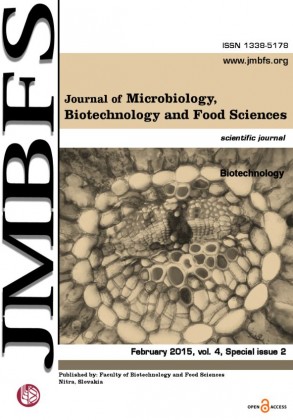THE CHANGES IN ALBUMIN CONCENTRATION AFTER ACRYLAMIDE EXPOSURE IN MICE BRAIN STRUCTURES
DOI:
https://doi.org/10.15414/jmbfs.2015.4.special2.54-56Keywords:
Albumins, brain, acrylamide, oxidative stressAbstract
Acrylamide is a chemical compound that typically forms in starchy food products during high-temperature cooking, including frying, baking and roasting. Acrylamide is a known lethal neurotoxin. Albumin is an important molecule under physiological and pathophysiological conditions. It has multiple effects, including regulation of osmotic pressure; carrier of poorly water soluble molecules, such as hormones, cholesterol, calcium, iron, bilirubin, free fatty acids, and drugs; and anti-oxidant properties. The aim of work was to estimate the content of albumins after acrylamide in the: right hemisphere, left hemisphere, cerebellum and brain stem. Although no high significant changes after each time, there occured influence of acrylamide albumins concentration. Significantly decreased content of albumins occures in oxidative stress.Downloads
Download data is not yet available.
Downloads
Published
2015-02-02
How to Cite
KopaÅ„ska, M., Zagata, P., GÅ‚ogowska, M., & Formicki, G. (2015). THE CHANGES IN ALBUMIN CONCENTRATION AFTER ACRYLAMIDE EXPOSURE IN MICE BRAIN STRUCTURES. Journal of Microbiology, Biotechnology and Food Sciences, 4(special issue 2 (Biotechnology), 54–56. https://doi.org/10.15414/jmbfs.2015.4.special2.54-56
Issue
Section
Biotechnology
License
Copyright (c) 2015 Marta Kopańska, Patrycja Zagata, Marta Głogowska, Grzegorz Formicki

This work is licensed under a Creative Commons Attribution 4.0 International License.
All papers published in the Journal of Microbiology, Biotechnology and Food Sciences are published under a CC-BY licence (CC-BY 4.0). Published materials can be shared (copy and redistribute the material in any medium or format) and adapted (remix, transform, and build upon the material for any purpose, even commercially) with specifying the author(s).





